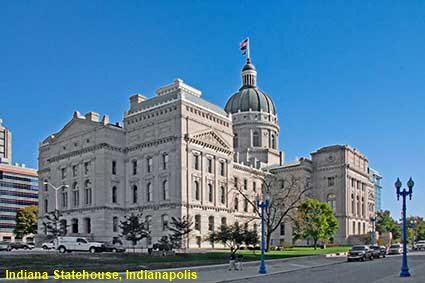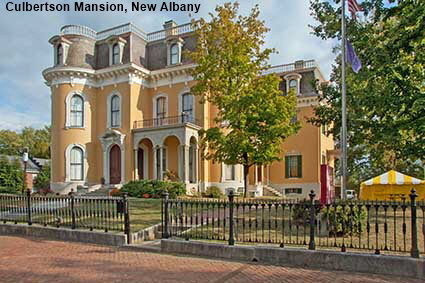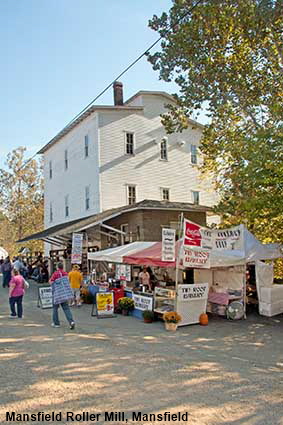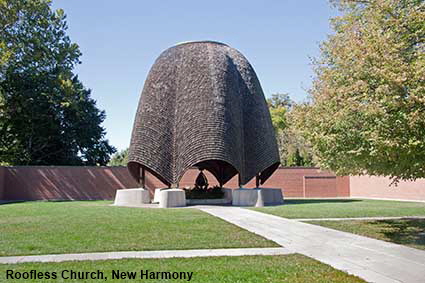Indiana
In 1679 René-Robert Cavelier, Sieur de La Salle set out to explore the Great Lakes area in a ship called the Griffon. La Salle and his team left the Griffon at Green Bay to explore the southern shores of Lake Michigan by canoe. Near the south of the lake, in modern day Michigan, they found the mouth of the St Joseph River and made camp to await supplies. Unknown to them the Griffon had sunk, but with winter looming and no sign of supplies they decided to move upstream. They set up a new camp by the south bend of the river, where South Bend, Indiana now stands. They were the first Europeans known to enter Indiana. La Salle continued to travel south to the mouth of the Mississippi, claiming all of the lands that he had discovered for France. Fur traders followed and in 1715 Fort Miami was built where the city of Fort Wayne now stands. The French & Indian War ended in 1763 leaving the British in control of Canada and the area east of the Mississippi. During the American Revolution George Rogers Clark secured much of southern Indiana for the Revolutionary side and after the war the land south of the Great Lakes became part of the USA. After the war ended, the area became engulfed in wars between the US and Indian tribes. In 1787 the US established the Northwest Territory in the land between the Appalachians and the Mississippi, north of the Ohio River. In 1800 the Indiana Territory was formed, the name coming from the Indiana Land Company which had unsuccessfully claimed the land. on December 11, 1816 Indiana became the 19th state of the USA.
Indiana Statehouse, Indianapolis
The Indiana Territory was established in 1800 with its capital at Vincennes, an old French colonial city in the south west of the territory. In 1813 the territorial capital moved to Corydon in the southeast of the territory to bring the seat of power closer to the Ohio River, which was the primary route into Indiana for settlers. When Indiana became a state Corydon remained the capital. The original limestone Corydon Statehouse has been preserved as Corydon Capitol State Historic Site. As settlement moved northward from the Ohio River, it was decided that the capital should move to a more central location. The site selected in January 1821 became the the city of Indianapolis. The state government relocated there in December 1824, initially using the Marion County Courthouse as its Statehouse. A purpose built Statehouse opened in 1835 but in the 1860’s the foundations became unstable and the ceiling of the House of Representatives collapsed. The government moved to an office building in 1876 and in 1877 the Statehouse was demolished. Construction of the current Statehouse to a design by Indianapolis architect Edwin May began in 1880, despite his death earlier that year. The General Assembly held its first session in the new Statehouse on January 6, 1887 but construction continued until September 1888. The Indiana Statehouse is open for tours.
Culbertson Mansion, E Main Street, New Albany
New Albany sits on the bank of the Ohio River opposite Louisville, Kentucky. William Culbertson was born in 1814 in New Market, Pennsylvania, but at age 21 and he left for Louisville. He worked for a dry goods merchant for 6 months before moving across the river to work in General Alexander S Burnett’s dry goods store. In 1854 he started his own utility company and became so successful that he was reputed to the the richest man in Indiana. In 1867, Culbertson built a mansion in New Albany at a cost of around $120,000. He died in 1892 and the family sold the mansion in 1899. It passed through the hands of several owners before in 1976 the State of Indiana bought it. The house was restored the mansion to the way it would have looked in Culbertson’s time and it is open to the public as Culbertson Mansion State Historic Site. In 1873, moved by the plight of women widowed by the Civil War, William Culbertson funded the building of a Widows Home and provided an endowment for its operation. This Italianat building still stands a short distance along the street from his mansion. Click Tab 2 to see the Culbertson Widows Home.
Covered Bridge Festival, Mansfield
Parke County, Indiana has 31 Covered Bridges, and considers itself to be the ‘Covered Bridge Capital of the World’. Every year in October a ten day long Covered Bridge Festival is held to showcase the bridges. The headquarters of the event is in Rockville, but the villages of Mansfield and Bridgeton also get into the swing of it with their streets lined with colourful stalls. This picture shows some of the stalls in Mansfield, and some pretty good fall foliage.
Mansfield Roller Mill, Mansfield
The village of New Dublin was founded in 1820 but within a couple of years its name had changed to Dickn's Mills, and later it became known as Strain's Mills. In the 1930s the village changed its name again to Mansfield, and that name sees to have stuck. The heart of the village from its foundation has been a water powered roller mill built by James Kelsey and Francis Dickson. Originally a grist mill, a sash mill for sawing wood was added in 1830 and was followed by a carding mill to process wool. In 1874 Jacob Rohm bought the mill and he built a new mill in 1880. The mill and several other buildings were owned between 1973 & 1978 by actor Tex Kelly who had plans to turn Mansfield into a Frontier City, but the plans were never implemented. The mill was bought by the Hutcheson and Dalton families in 1991 and they donated it to the Indiana State Museum System who restored the turbine driven grist mill. Historic Mansfield Roller Mill is open to the public from the end of April to the end of October, check the web site for the days that it is open. Click Tab 2 to see the some of the machinery inside the mill.
Click on Minimap to navigate
DLU150216




We have more pages on Indiana. Click below or on the Minimap:





Roofless Church, New Harmony
New Harmony was founded by the Harmony Society, a group of Germans who separated from the Lutheran Church. They suffered persecution in Germany so they moved to America. The town has many historic buildings many dating back to the Harmonist era, and you can find out more about these in the New Harmony page. There is one modern building of particular note in the town. The roofless church was the brainchild of New Harmony resident Jane Blaffer Owen who commissioned Architect Philip Johnson to design it. The design was driven by the belief that the only roof large enough to encompass a world of worshippers was the sky. It opened as a non-denominational church in 1960. The dome shown in this picture stands the west wing of the church and is constructed of laminated pine arches which are covered in cedar shingles. The dome houses a sculpture by Jacques Lipchitz called ‘The Descent of the Holy Spirit’. The Roofless Church is a popular location for religious ceremonies including weddings.
© Mike Elsden 1981 - 2025
The contents of this page may not be reproduced in full or in part without permission